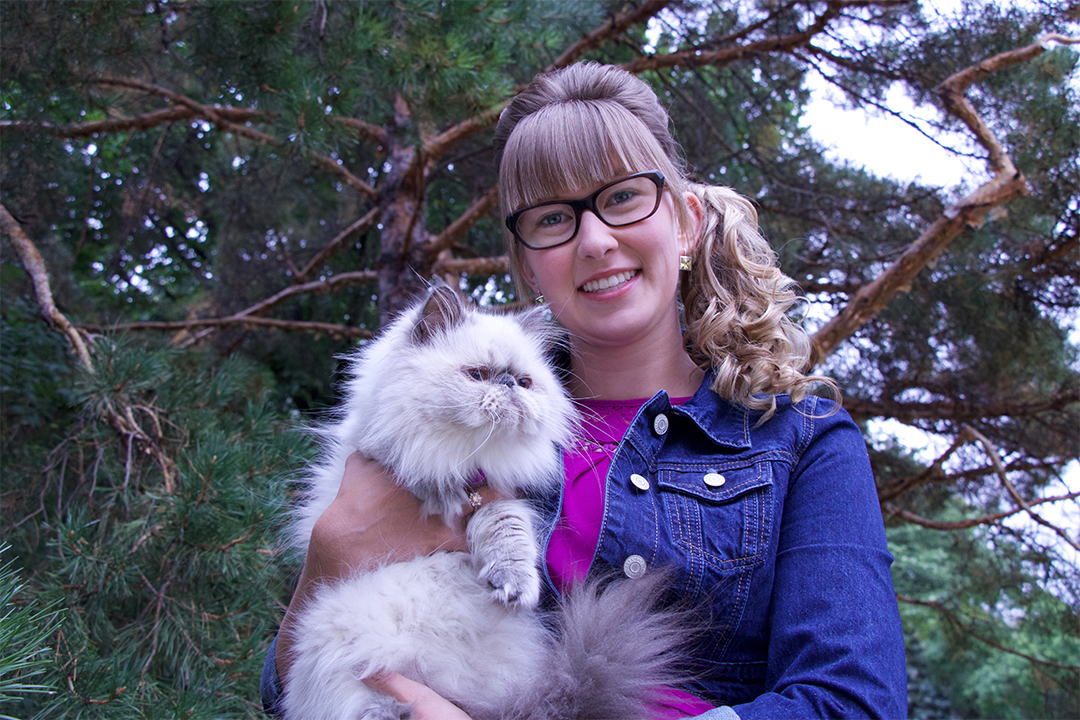
Persistence pays off for veterinary student
The day Kaitlyn McIntyre received her acceptance into the Western College of Veterinary Medicine (WCVM) this spring, she faced an excruciating dilemma.
By Kathy FitzpatrickIt had taken her four tries, during which she completed degrees in kinesiology and education at the University of Saskatchewan – a six-year effort.
“I walked out of my second convocation this spring, and I opened my acceptance letter … and I just cried I was so excited,” McIntyre says. “And two hours later I got a call from the school that I interned at, and they offered me a full-time teaching position.”
McIntyre has wanted to be a veterinarian from the time she was a little girl growing up in D’Arcy, Sask. But she always wondered if she could overcome her squeamishness.
So instead, she enrolled in the U of S College of Kinesiology. However, a second-year human anatomy course convinced her that if she could deal with human cadavers, she could handle just about anything. So she went after her dream of getting into veterinary school.
McIntyre’s first two WCVM applications were rejected before the interview stage, but she persevered – working to bring up her marks while also gathering as much experience as she could. She put in countless volunteer hours in veterinary clinics, farms and community organizations. She went owl-banding with a friend, and she joined the pre-vet club at the U of S.
During her teaching internship at the Whitecap Dakota First Nation, she brought animals into the classroom to help children overcome their fear of the local wildlife.
Even after two years of achieving a 90-plus average in her courses, McIntyre felt unsure she would get in to the WCVM.
After her third application, she was called for a second-round interview with members of the WCVM’s admissions committee for Saskatchewan applicants. She recalls being asked about her personality and her experience in working with people. Her fourth try got her a first-round interview.
McIntyre had five days to make up her mind whether to accept the seat at WCVM – one of just 20 designated for Saskatchewan residents. She worried that if she turned down the offer, it may never come again. After an evening of talking it over, McIntyre clicked her acceptance on line.
“I couldn’t wonder for the rest of my life what it would have been like,” she explains.
* * *
It’s not uncommon to see pre-veterinary students apply at least twice before being accepted to the WCVM’s four-year Doctor of Veterinary Medicine (DVM) program, says Heather Mandeville, the college’s manager of admissions and recruitment. And every year, there are a few students who have attempted as many as six times before being accepted.
As a regional veterinary college, the WCVM annually accepts 78 students from Western Canada and the northern territories based on an interprovincial agreement with the four western provinces.
This year, the WCVM received 98 applications from Saskatchewan-based students — an increase of nearly 25 per cent in comparison to last year’s numbers. That jump in Saskatchewan applicants has taken Mandeville by surprise. She has no definitive theory but thinks it may be due to a combination of factors.
“Province-hoppers” probably account for approximately 10 to 15 of Saskatchewan’s applicants each year, Mandeville says. The term refers to applicants who relocate from another province — commonly from B.C. or Alberta, where the ratio of applicants to seats is six or seven to one — to Saskatchewan where the applicant ratio is usually three or four to one seat.
Another potential influence is that the WCVM has stepped up its recruitment efforts in Saskatchewan. As well, students at the University of Regina now have a pre-vet club that’s similar to the one at the U of S. These student-run organizations help encourage prospective students, providing them with peer support and keeping them in touch with the veterinary profession.
The applicant pool in Manitoba has also increased — climbing from less than 40 to around 70 in the past seven years, thanks to developments such as a new pre-vet club at Brandon University. Further west, the WCVM’s admissions team uses videoconferencing to connect with students at UBC-Okanagan and UNBC in Prince George, B.C.
The University of Calgary launched its own veterinary school (Faculty of Veterinary Medicine) in 2008, but “our Alberta numbers keep climbing,” Mandeville says.
Overall, the total number of applicants continues to increase: in 2017, the college received 461 applications — 31 more than in 2016.
The rising number of applicants for the DVM program means students require higher grades every year to be accepted at the WCVM, Mandeville acknowledges.
* * *
The suspense is now over, and Kaitlyn McIntyre started her first-year classes at the WCVM in August 2017.
She knows she’s up for the challenge: McIntyre is a single mother to her daughter Matalynn, who was born partway through her undergraduate studies. She’s thankful for her family’s support. Graduation is still four years away, but McIntyre looks forward to the day when she can raise her little girl in rural Saskatchewan, combining veterinary practice with her love for education and animals.
Kathy Fitzpatrick is a freelance journalist in Saskatoon. Born in Manitoba, she has spent close to four decades working in media — including radio, television, print and digital.
